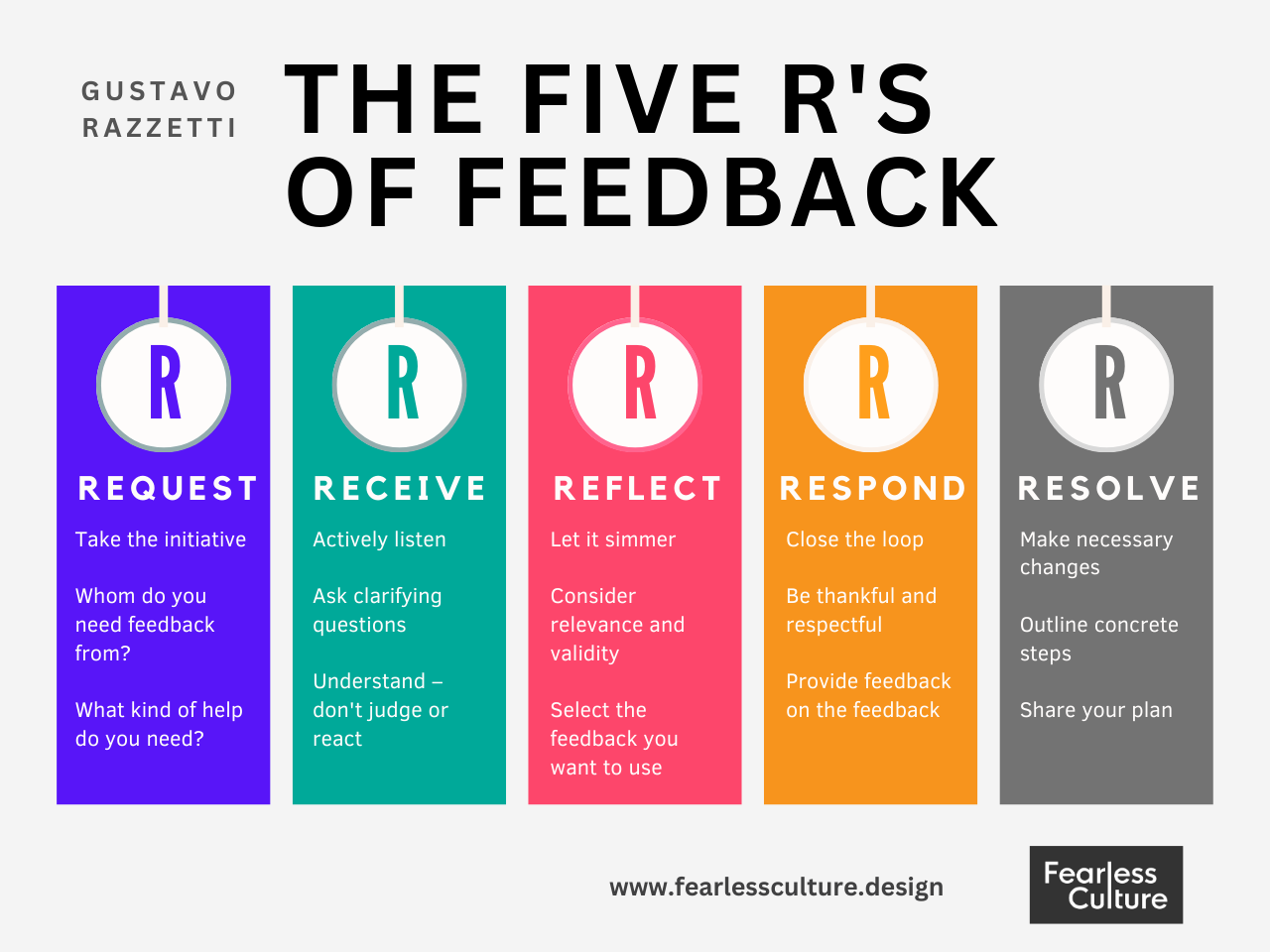The Feedback You Resist Is The One You Need Most
When beta readers made me swallow my own advice (and why you should too)

The feedback that helps you grow isn’t the praise that makes you feel good, but the criticism you resist. That’s the feedback you really need.
The toughest feedback I got on my Forward Talk manuscript wasn’t about grammar or typos. It was about feeling pulled in opposite directions. What one reader loved, another hated. What seemed essential to some felt unnecessary to others.
Feedback is often messy and contradictory. It carries the fingerprint of the giver. Instead of dismissing what confused me, I pushed myself to uncover the deeper meaning.
This is familiar territory. Feedback is central to my work. I facilitate workshops and have developed multiple feedback frameworks—but this time, I wasn’t in the driver’s seat. I was the passenger.
When I shared the manuscript with beta readers, I had to swallow my own advice. It was ironic. However, the lessons I learned can help you too, no book needed.
1. Frame the Ask
When you request feedback, you’re more open to receiving it. Better yet, you set the rules, defining the type of feedback you need—and from whom.
I picked my beta readers with care. Some knew me well enough to be brutally honest. Others brought fresh eyes, free from emotional baggage. I also included seasoned beta readers who understand the difference between reviewing a manuscript versus a finished book.
Most people want to fix your work by prescribing solutions. Framing the ask prevents this. From my previous book, I learned to set clear expectations. I didn’t want readers to rewrite my book. Instead, I wanted to know what worked, what didn’t, what was missing, and what to cut. I wanted a conversation (“give me clues”), not a review (“give me a score”).
I used BetaReader.io to organize the feedback experience. Rather than just getting comments on specific lines, I asked for feedback on each chapter and had readers fill out a survey after each section.
I invited them to focus on three main things:
- Clarity: Were the ideas and writing easy to understand?
- Applicability: Were the model, solutions, and tools easy to use and useful for real-life problems?
- Originality: Did the book offer something new and valuable?
Setting clear rules helps everyone. Readers told me the instructions made giving feedback easier and more intentional. Everyone felt their time was appreciated. Being thoughtful showed that I valued their input and would review it carefully, too.
Before you request feedback, ask yourself:
- What do you want feedback on? What don’t you want feedback on?
- What kind of help do you need?
- Who are the right people to ask?
- How will you show you’re open to being challenged?
2. Separate Love from Insight
Constructive feedback upsets us because it feels like a personal attack. But appreciative feedback alone can be a problem, too. It stops us from growing.
I’m human. I loved comments like “this is seminal work,” “I wish I had this book 10 years ago,” or “game‑changing.” These remarks confirmed I was on the right track.
But I needed to pay the same to criticism, too. Maybe even more so.
I received feedback from fifteen readers. Some read it three times. It was a lot to take in. At first, I couldn’t help checking random comments and found myself reacting to both pleasant and harsh feedback. This wasn’t helping me.
So I took a step back. No peeking until everyone was done. Then I focused on understanding the big picture instead of getting distracted by small details.
My approach was systematic.
First, I analyzed survey responses. Second, I reviewed chapter feedback to find patterns. Third, I dug into the inline comments without overreacting to them. Finally, I categorized all the feedback into three groups:
1. What people liked
2. What they didn’t like because it was unclear, repetitive, or unnecessary
3. What ifs? (Treating requests as hypotheses, not instructions)
I went through everything three times: first to understand the feedback, then to process my feelings and reactions, and finally to challenge myself by exploring everything that made me uncomfortable.
When you receive feedback, consider:
- What feedback makes you feel defensive?
- Why are you reacting this way?
- Are you letting praise stop you from improving?
- Which comments hurt, and what truths might they contain?
3. Let the Dust Settle
Feedback’s real value comes later, not in the moment. Rather than reacting right away, let it simmer. You’ll start to see patterns naturally emerge when the time is right.
Even with clear guidelines, people will be people. Some went off-topic, others shared long stories about their experiences. At first, I thought these weren’t helpful. Then I remembered something I share in my workshops: feedback is just someone’s perspective, not the absolute truth. Everyone gives feedback based on who they are. Their experiences and personalities shape what they notice.
Letting the dust settle helped me find its value. Some stories showed my book connected with them. Others seemed off-topic but still taught me something unexpected. Their words were human and authentic. It inspired me to challenge my own to better connect with readers.
This waiting period helped me question my ideas and look at feedback (more) objectively. One reader said parts of a section sounded “academic… even pedantic.” Another pitched the idea of adding comic strips to illustrate key points.
My first thoughts about comics? That doesn’t fit the book’s style. However, now I’m exploring this idea with the reader who suggested it.
The person who called my writing pedantic couldn’t explain exactly why at first, but after a few emails, he suggested using less jargon and more stories—show, don’t tell. That feedback hurt because it was true.
Before making changes, reflect on the feedback:
- What’s the hidden message behind comments that seem off-topic?
- What do you notice after letting the dust settle?
- How can you focus on the insights, not just who said it?
- What feedback are you dismissing too quickly? Why?
While writing this article, I realized I was instinctively following my own Five R’s of Feedback model. It’s funny how swallowing my own medicine works. Check it out if you’re interested, or feel free to continue reading.
4. Separate Signal from Noise
Feedback is just someone’s perspective, not the absolute truth. Think of it as a gift that might help you or distract you. Just like any gift, be grateful and open-minded, but you get to decide what to do with it.
This is especially true when you get feedback from many people at once, like I did with my book. It’s tempting to try to please everyone. After all, people spent time reading my manuscript, and I want my readers to be happy, right? Wrong. The real challenge is improving your work without losing your soul.
Of course, my readers had conflicting opinions. Some wanted chapter summaries. Others threatened to throw the book if they saw a single recap. Many wanted how-to tips; others wanted more stories. If I tried to address every comment, I would have ended up with a group designed by a committee. Ironically, groupthink is exactly the kind of bad conversational pattern that Forward Talk helps prevent.
One big issue was about introducing some tools earlier in the book. I originally structured it in the same way that I apply the framework with my clients. Improving team conversations means fixing root problems, not just symptoms. It’s like peeling an onion, layer by layer.
After reflecting on the feedback, I moved the end of the book to the beginning.
I didn’t compromise the main structure. I kept it intact while giving readers some practical tools to start with. By sticking to the three guiding principles I set for my book, the decision felt easier:
- Authenticity: I won’t oversimplify the book at the expense of reducing the real impact.
- Traction early: I’ll give readers simple exercises they can apply right away without downplaying the real work teams need to do.
- System integrity: Every change should make the overall approach stronger, not add noise.
These principles became my compass. I cut passages that sounded like lecturing, improved the flow, and replaced many explanations with stories (same point, different delivery).
When you respond to feedback, ask yourself:
- What are your non-negotiables, even when feedback is pulling you in a different direction?
- How can you see feedback as a question rather than an instruction?
- What feedback will you acknowledge but not act on? Why?
- If you try to please everyone, who (or what) are you betraying?
5. Close the Loop
Many people forget to follow up after receiving feedback. If you want people to help you again, let them know what you did with their input. You don’t need to respond to every piece of advice you receive, but share what you intend to do.
I thanked my beta readers on social media, replied to their comments in the reading app, and sent a couple of update emails. I wanted to keep them informed without overwhelming them.
Keeping people in the loop isn’t just about appreciation; it’s about continuing the conversation. I reached out to some readers who suggested creating a visual map that connected all the book concepts, from structure and goals to tools and outcomes. When I shared my draft with them, they gave feedback to improve this map.
One reader pointed out that I had a canvas for every part of the book except for Part 3. I ignored this at first. Then I realized she was right, so I turned an exercise from another section into a canvas for that section.
Feedback isn’t a one-time transaction; it’s a relationship. I wanted my readers to feel like they were part of my journey, not just contributors. When someone asks for your feedback and then disappears, trust evaporates. But when you circle back to share what changed (or didn’t), people feel their time was well spent.
To resolve and close the loop:
- Who are you leaving in the dark, and what might that cost you?
- How can you turn feedback into an ongoing conversation?
- How will you thank the people who help you get there?
- Are you willing to discuss why you rejected some feedback, not just what you accepted?
I didn’t learn about feedback for the first time while writing this book, but I had to swallow my own medicine. It was painful at times, but it definitely made the book sharper.
Forward Talk is about cleaning up conversational debt. Editing it forced me to pay down some of my own. It wasn’t easy, but it was worth it. Thank you, beta readers, for keeping me honest.
Connect & Work With Gustavo
New to this newsletter? Subscribe for free.
Let’s connect on LinkedIn
Schedule a free consultation call to discuss your culture design project. and how we help teams and organizations build fearless cultures
Join the Culture Design Masterclass. Master the most effective framework for making culture tangible and actionable. Book your seat now.



